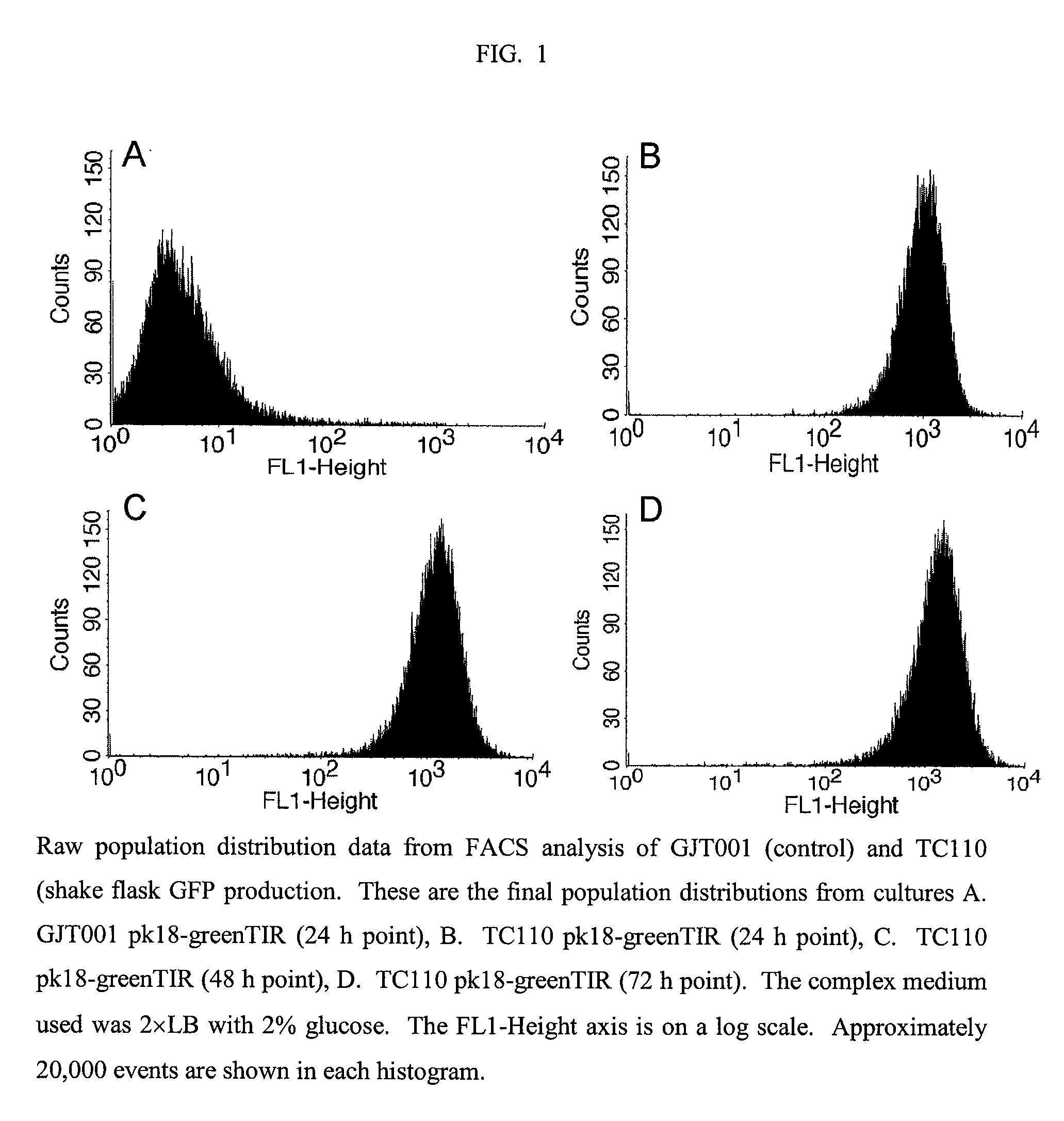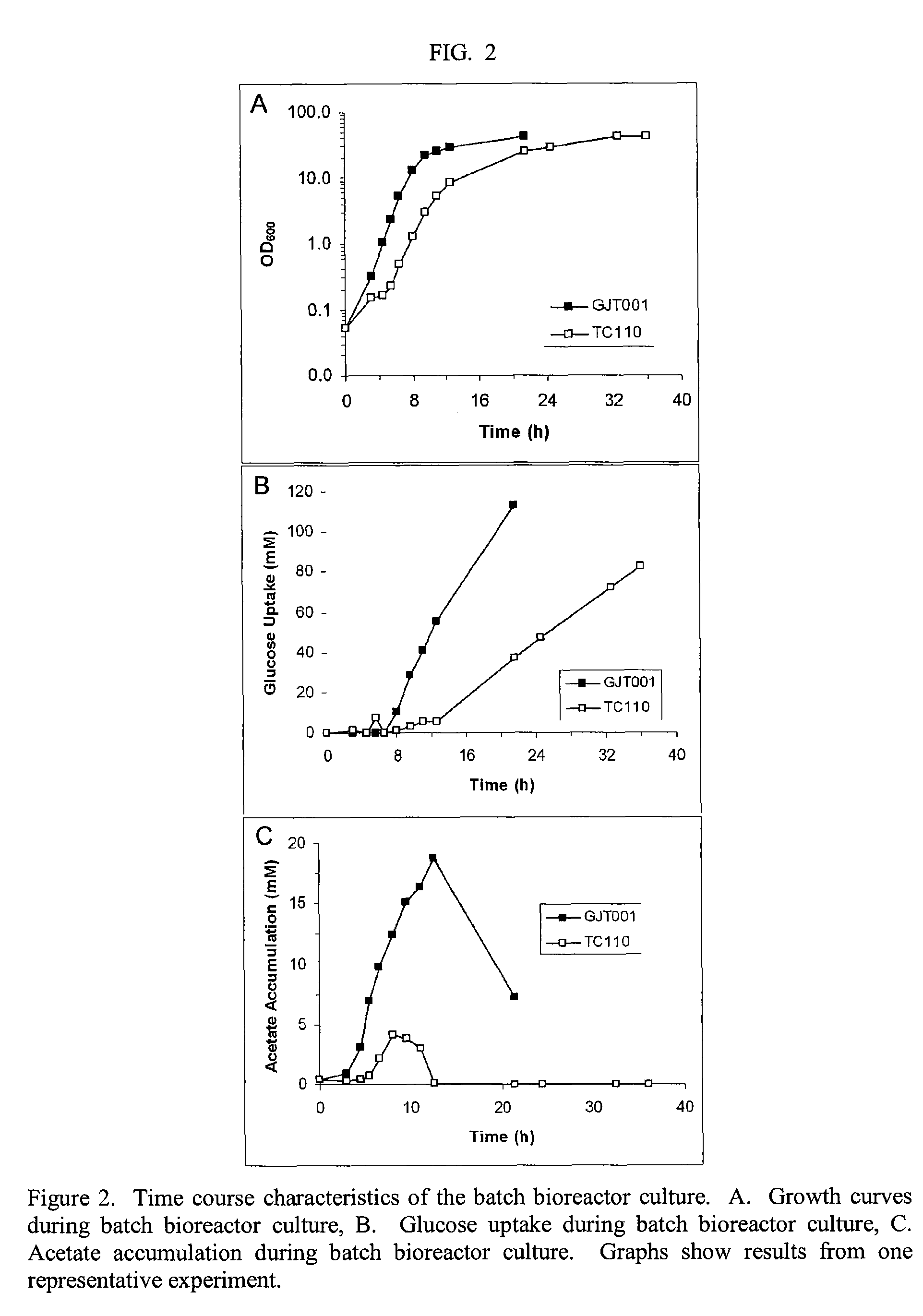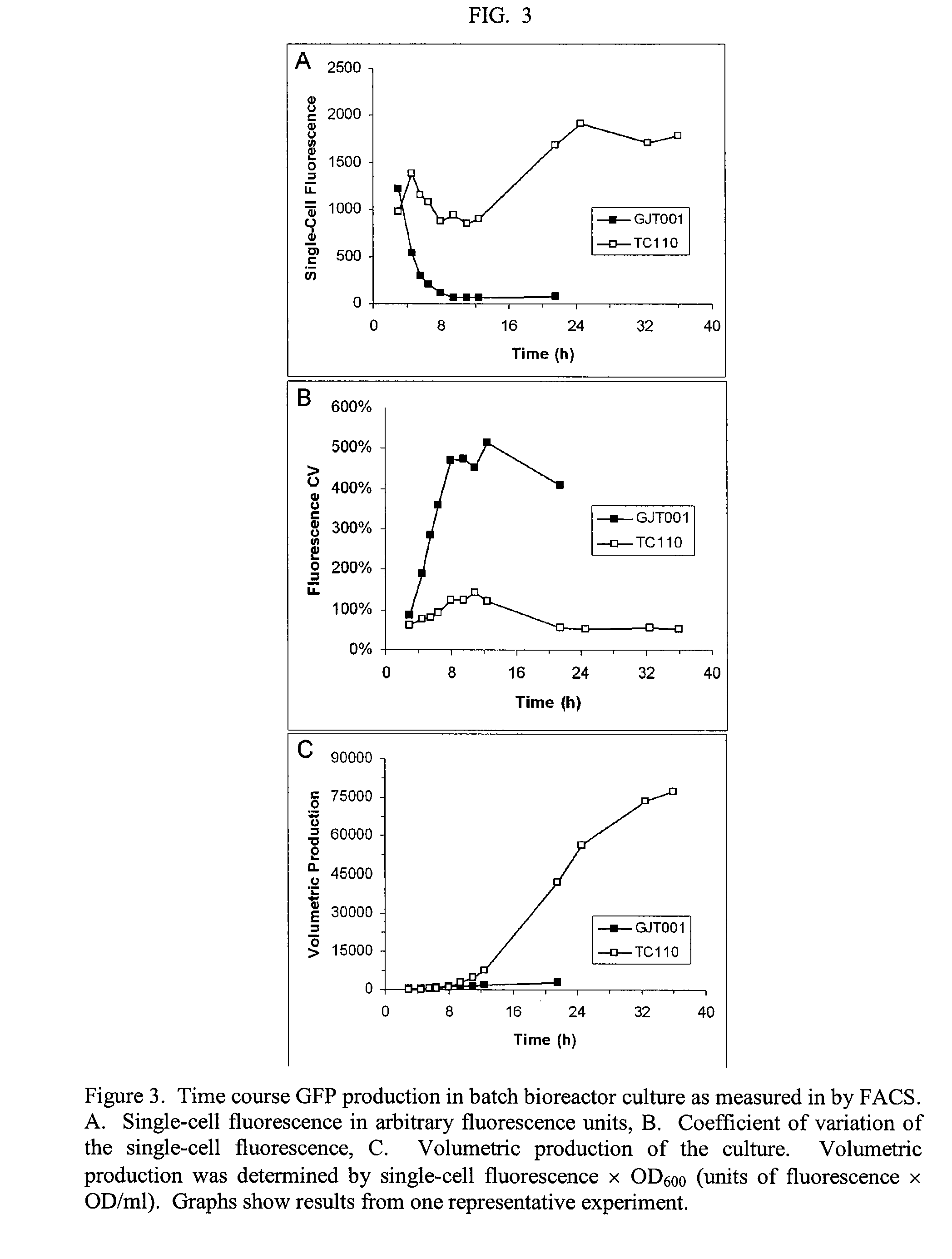Reduced phosphotransferase system activity in bacteria
a phosphotransferase and bacteria technology, applied in the field of bacteria phosphotransferase system activity reduction, can solve the problems of acetate production as a fermentation byproduct, undesirable acetate, and acetate excretion, and achieve the effect of increasing gfp production
- Summary
- Abstract
- Description
- Claims
- Application Information
AI Technical Summary
Benefits of technology
Problems solved by technology
Method used
Image
Examples
example 1
Mutant Production and Growth
[0042]
TABLE 2Strains and PlasmidsCharacteristicsSourceStrainsGJT001Control: Spontaneous cadR mutant of MC4100Tolentino, 1992(ATCC35395) Δlac(arg-lac)U169rpsL150relA1 ptsFSmRTC110GJT001 ΔptsHIThis studyPlasmidspCR2.1-TOPOApR, KmR, Plac, pUC ori, f1 oriInvitrogenp10044glf from Zymamonas mobilis in pCR2.1-TOPOThis studypk18-greenTIRgfp from Aequorea victoria in pk18Miller & Lindow,1997pk18-lacZlacZ from Escherichia coli in pk18This study
[0043]The strains and plasmids used in this study are listed in Table 2. The mutant ΔptsHI strain (TC110) was constructed using the Datsenko and Wanner method (Datsenko and Wanner, 2000). The mutations were done sequentially: ptsHI was deleted from GJT001, and lacIYZ was deleted from GJT001 ΔptsHI. In short, a linear DNA was constructed using PCR. The sequences of primers for ptsHI are not shown. The linear DNA contained bases that were homologous to the upstream region of the gene of interest, the kanamycin (Km) resistance g...
example 2
Acetate Eliminated
[0045]Once the needed control (GJT001) and ΔptsHI (TC110) cells were made, we measured cell growth by increase in optical density and glucose consumption, and also measured acetate production.
[0046]
TABLE 3Growth and metabolite data from shake flask GFP production studyMediumIncuba-GlucoseAcetate& %tionConsumedAccumulatedStrainGlucose(h)OD600(mM)(mM)GJT001LB + 1%246.6 ± 0.136.9 ± 0.355.5 ± 1.6 LB + 2%246.8 ± 0.244.7 ± 1.373.4 ± 0.9 2 × LB +248.0 ± 0.246.8 ± 0.890.4 ± 1.6 2%TC110LB + 1%2413.8 ± 0.6*26.4 ± 0.60.0 ± 0.0*4818.8 ± 0.2* 58.5 ± 0.1*0.0 ± 0.0*LB + 2%2413.0 ± 0.7*29.9 ± 1.70.0 ± 0.0*4819.0 ± 0.7* 87.9 ± 3.4*1.3 ± 1.9*2 × LB +2414.8 ± 0.4*27.0 ± 1.60.1 ± 0.2*2%4818.8 ± 0.8* 64.6 ± 5.2*0.0 ± 0.0*7223.5 ± 0.7*116.1 ± 0.5*9.1 ± 6.6*
[0047]Fermentations were conducted at 32° C. 1% glucose˜56 mM and 2% glucose˜112 mM. Medium indicates the type of medium used and the starting glucose content. OD600 is the final optical density of the culture. Glucose Consumed shows ...
example 3
Protein Increased
[0050]Once we confirmed that acetate was greatly reduced in the ΔptsHI mutant, we then measured the production of a reporter protein, in this case green fluorescent protein (GFP), in control GFP producing cells (GJT001 pk18-greenTIR) and ΔptsHI GFP producing cells (TC110 pk18-greenTIR).
[0051]
TABLE 4Flow cytometry data from shake flask GFP production studyMedium &IncubationSingle-CellFluorescenceVolumetricStrain% glucose(h)FluorescenceCVProductivityGJT001LB + 1%2410.9 ± 0.5402% ± 34% 71.2 ± 3.1pk18-LB + 2%2410.2 ± 1.3673% ± 21% 69.7 ± 9.2greenTIR2 × LB + 2%2410.6 ± 1.3467% ± 35% 84.3 ± 10.5TC110LB + 1%24 730 ± 17*47% ± 1%*10089 ± 470*pk18-48 729 ± 21*47% ± 0%*13732 ± 430*greenTIRLB + 2%24900 ± 4*63% ± 1%*11727 ± 630*481017 ± 32*64% ± 1%*19276 ± 930*2 × LB + 2%241056 ± 4* 49% ± 2%*15575 ± 470*481337 ± 50*52% ± 1%* 25082 ± 1400*721392 ± 41*55% ± 1%* 32728 ± 1400*
[0052]Fermentations were conducted at 32° C. 1% glucose˜56 mM and 2% glucose˜112 mM. Medium indicates the t...
PUM
| Property | Measurement | Unit |
|---|---|---|
| concentrations | aaaaa | aaaaa |
| concentration | aaaaa | aaaaa |
| width | aaaaa | aaaaa |
Abstract
Description
Claims
Application Information
 Login to View More
Login to View More - R&D
- Intellectual Property
- Life Sciences
- Materials
- Tech Scout
- Unparalleled Data Quality
- Higher Quality Content
- 60% Fewer Hallucinations
Browse by: Latest US Patents, China's latest patents, Technical Efficacy Thesaurus, Application Domain, Technology Topic, Popular Technical Reports.
© 2025 PatSnap. All rights reserved.Legal|Privacy policy|Modern Slavery Act Transparency Statement|Sitemap|About US| Contact US: help@patsnap.com



